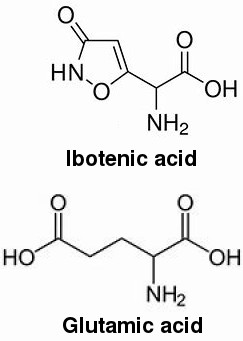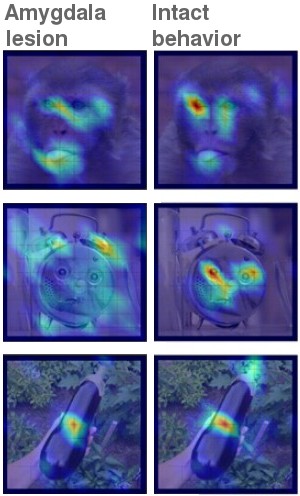 was all set to write a devastatingly witty article on quantum cryptography,
maybe adding a joke about how, using the old way of sending a cat through the mail,
one could never be sure whether the cat would arrive alive or dead, and now you can
have both.
was all set to write a devastatingly witty article on quantum cryptography,
maybe adding a joke about how, using the old way of sending a cat through the mail,
one could never be sure whether the cat would arrive alive or dead, and now you can
have both.
Then it happened again. Some journalist at the libertarian website Reason wrote an article making an inflammatory claim. He wrote “Researchers at the National Institutes of Health reportedly damaged monkeys' brains with acid before showing them pictures of fruit.”

Glutamic and ibotenic acid
The author says he's been sending multiple Freedom of Information requests and he's not happy with what he got back. He pretends to be fighting government waste, but it sounds more like he's harassing the scientists because he's opposed to animal research and doesn't want to say so.
What did those Josef Mengeles at NIH do? Dissolve the animals' brains by pouring sulfuric acid on them and videotape themselves laughing over the screaming? No. Not even close. In chemistry, an acid simply means that, like aspirin or monosodium glutamate, it has a carboxylic acid group. The “acid” in question is ibotenic acid (see structure at right), a derivative of monosodium glutamate or MSG, which acts as a neurotransmitter in the brain.
MSG is known for Chinese restaurant syndrome (which, the Internet informs me, is now a “super racist” term). It overexcites your brain, causing a flushed face, palpitations, numbness, and headaches. When microinjected stereotaxically into the brain, ibotenic acid acts much like MSG, only stronger. MSG can overstimulate the brain, killing neurons; ibotenic acid is more potent, and kills neurons more efficiently: the injection volumes were 0.6 to 1.2 microliters, smaller than the head of a pin. But it doesn't kill neurons because it's an acid. It kills them because it allows too much calcium to enter the neurons, just as MSG would do in a bad case of Chinese restaurant syndrome.
In the freely available PNAS article describing the research, we can read that Taubert et al. were not just showing the animals pictures of fruit for no reason. They were studying how we identify faces. The amygdala determines our fear response to novel stimuli. Like people, monkeys spend more time looking at pictures of other monkeys than inanimate objects. It's usually thought that the inferior temporal cortex, where face perception occurs, decides whether we should look at a face, and that the amygdala is only important for stimuli that provoke fear.

Visual saliency maps from the paper showing how lesioning the amygdala reduced the attention the animals paid to facial features. Note that an eggplant (usually thought of as a vegetable, but technically a berry) was used. The authors also showed a bell pepper, which is also classified as a berry. So Reason got this part right.
The authors hypothesized that the amygdala also played a role in attention. So they showed three types of photos: other monkeys, fruit or alarm clocks with face-like features on them, and ordinary fruit. Then they measured whether the amygdala controlled how long the animals would fixate their gaze at each picture. It did, proving that the emotional response from the amygdala is involved in guiding eye movements toward face stimuli, and therefore it is important in social communication.
This is important in understanding autism spectrum disorders: we now know that humans use the amygdala to orient our attention to other people. Orienting toward faces is something we have to learn in childhood; if we're raised without exposure to faces, our brains don't develop this feature, and we have trouble interacting with other people—a classic feature of ASD.
Now, I admit I would have done the experiment differently, maybe by anesthetizing the amygdala rather than ablating it. That would have allowed post-testing to see if the new behaviour was retained. And it would have let me use the rhesus monkeys for other experiments. But this experiment is not difficult to understand. In fact, it's surprising that the reporter didn't have the basic science knowledge to understand it. Or maybe he did, but he misrepresented it anyway.
By the way, using monkeys is considered extremely hazardous research: monkeys frequently bite, they can carry B virus, which is almost invariably fatal to humans, and they're insanely expensive to buy and care for. And the regulations for getting and using monkeys in research must be overwhelming.
I could come up with hundreds of examples of stupid grants that got funded. This is not one of them. It's an important finding and skilfully done research. By disguising his animal rights activism as opposition to wasteful spending, the reporter invites mistrust of his motives. He would've been better off to tie it to global warming: it's such a common trope in that field that nobody would notice.
It's a common trick: if your argument is too weak, use an emotional appeal and phrase it in such a way that it's technically true, knowing that your fellow activists will repeat the misrepresented claims until they become established truth. This is something that scientists must vigorously challenge.
People don't have to pretend to be talking about government waste. If you want to argue against animal research, argue against animal research. If you don't understand the science, ask us, and we'll be happy to explain it to you. But these days, if we find out you're a reporter, we probably won't even answer the phone.
jan 15 2020, 7:12 am. edited jan 16 2020, 4:46 pm
